Microsoft Word 2007 - Writing an Equation
1. On the Insert tab on Equation.

Select on Insert New Equation

Start typing your equation in the space provided.

Start typing your equation in the highlighted box. Type 2
Select the Script icon.
A Subscript and superscript templates box appears. Now select the first option (base raised to a power) so that you can
type ![]()
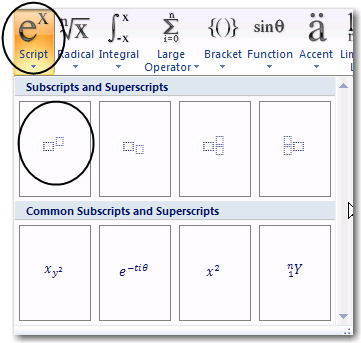
In the blank spaces type in the base (x) and the exponent (2), like this ![]()
Then press the right arrow button to escape the superscript box
Type +
Click the Fraction icon. Select the first option which allows for you to type in a numerator and denominator.
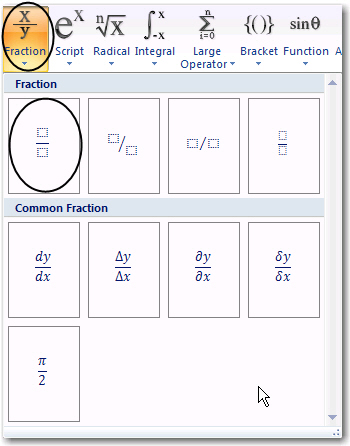
Then in the numerator type 6 and click Script. The Subscript and superscript templates box appears. Again select the first option (base raised to a power). Your equation will look like this.

Now
type ![]() next to the 6.
next to the 6.
Move to the denominator by using the down arrow. Type the -2x in the denominator and press the right arrow. Your equation should now look like this:

12. Click anywhere on the blank page to exit from the equation.
The equation is now represented as an image and you should treat it as an image. If you wish to move the equation on the page you will have to change the picture layout.
On the Insert tab, click on Equation.

Select on Insert New Equation

Start typing your equation in the space provided.

Start typing your equation in the highlighted box. Type cos2. When you reach the theta ( ![]() )sign...
)sign...
On the Design tab, find the symbols group. Scroll the available symbols to locate theta ![]()

Select theta and continue writing the equation in a similar fashion.
Click anywhere on the blank page to exit from the equation.
The equation is now represented as an image and you should treat it as an image. If you wish to move the equation on the page you will have to change the picture layout.
On the Insert tab, click on Equation.

Select on Insert New Equation

Start typing your equation in the space provided.

2. Type F=
3. Click on the Fraction icon. Select the first option.

Click in the upper block (numerator) of the fraction and type k
Click on the symbols for subscript and superscript templates. Select subscript (second option). Your numerator will now look like this: ![]() Type in
Type in ![]() in each square respectively.
in each square respectively.
Insert another subscript template so your numerator now looks like this:![]()
Now type in ![]()
Click the down arrow to move to the denominator (the lower block) of the fraction and Click on the symbols for subscript and superscript templates. Select superscript (first option).
Type in ![]()
Your equation should now look like this:
![]()
On the Insert tab, click on Equation.

Select on Insert New Equation

Start typing your equation in the space provided.

Start typing your equation in the highlighted box. Type F
On the Design tab, scroll the symbol group to find the increment ![]() symbol. Click the symbol.
symbol. Click the symbol.

Type in t =
On the Design tab, scroll the symbol group to find the increment ![]() symbol. Click the symbol to insert
symbol. Click the symbol to insert
Finally type p.
Your final equation should look like this:
![]()
1. On the Insert tab, click on Equation.

2. Select on Insert New Equation

3. Start typing your equation in the space provided.

4. A pop up equation toolbar appears and the equation is represented by a blank highlighted box.
5. Type s=
6. Click on the Fraction icon. Select the first option.

7. Then highlight the fraction and click Brackets. Select the first set of brackets.
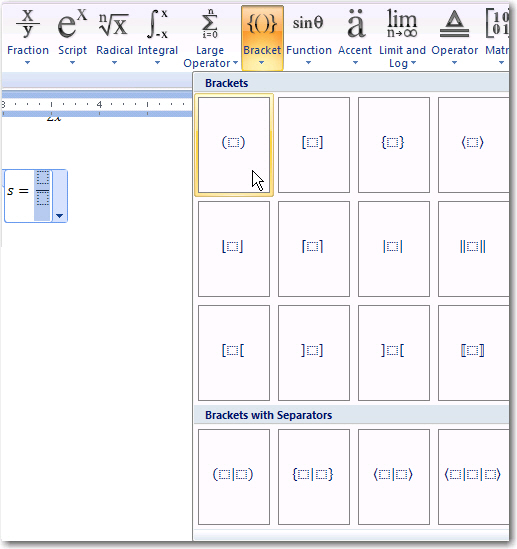
8. Type in u + v in the numerator and 2 in the denominator.
9. Use the right arrow to move right and now type t.
10. Your equation should now look like this:

1. On the Insert tab, click on Equation.

2. Select on Insert New Equation

3. Start typing your equation in the space provided.

4. A pop up equation toolbar appears and the equation is represented by a blank highlighted box.
5. Select the subscript and superscript templates and select the option that offers both subscript and superscript.
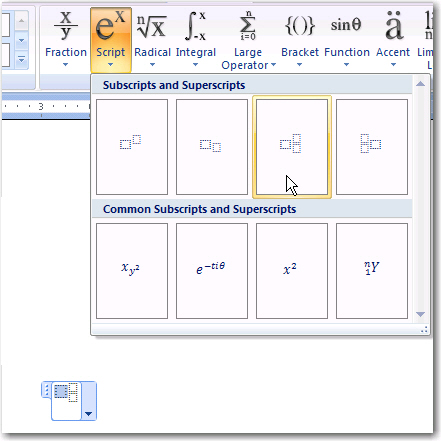
6. Type E. Then click in the superscript (upper) box and select the theta sign from the symbols group.
7. Then click in the subscript (lower) box and type in cell.

8. Press the right arrow to exit the sub/superscript boxes and continue typing the equation in a similar way.

7. Click anywhere on the blank page to exit from the equation.
1. Click on the drop down arrow in the equation box,
2. Select justification to move the equation to a desired location. Or select the 3 dots on teh left of th e equation box and drag it to a new position.
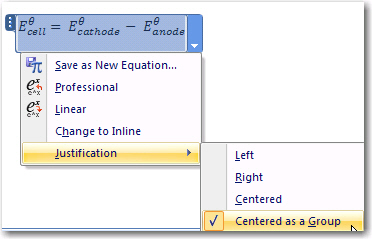
3. You are able to Save the new equation (very useful) if you will use it often.
4. Selecting the Professional option formats the equation to be in 2-D.
5. Linear option lets you see how the equation was written.
For example, take the equation 
Wriitng it in linear format: 
All Rights Reserved.
